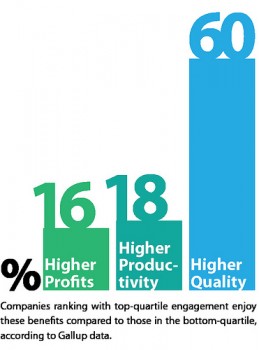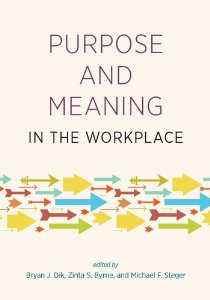 slworking2 via Compfight
slworking2 via Compfight
The way we typically talk and think about employee engagement may be all wrong.
We tend to classify workers into categories: they are either engaged or not engaged. For example, an oft-cited Gallup poll identifies 7 out of 10 workers as being either “not engaged” or “actively disengaged” meaning they are “emotionally disconnected” from their work and generally holding back the economy by not contributing meaningfully to the productivity of their companies.
Naturally, business leaders want to address this issue. They want to know how to get more engaged employees, how to identify and eliminate unengaged employees and they want to know the magic secret for converting unengaged employees into engaged ones.
These may well be excellent goals for any business, but they are based on a simplistic understanding of engagement. In a paper on “Employee Engagement and Meaningful Work,” authors William Kahn and Steven Fellows say that employees are not easily divided into “engaged” and “unengaged” buckets.
The reality is that over the course of any given work day or week, every employee is likely to have moments of engagement and moments of disengagement. And while some employees may be more engaged than others, all employees are likely to shift in and out of engagement during their time at work.
 We could consider this “engagement 2.0.” It’s not a stable trait that can be used to suss out the good employees from the bad, but a fluid state that employees might flow in and out of based on a variety of conditions and factors throughout their day.
We could consider this “engagement 2.0.” It’s not a stable trait that can be used to suss out the good employees from the bad, but a fluid state that employees might flow in and out of based on a variety of conditions and factors throughout their day.
This is not necessarily a new idea. Psychologists have long recognized this momentary state of optimal engagement or “flow” that occurs when people are able to use their strengths to meet a challenge in a self-directed way. But in corporate America, we have focused the conversation on “who’s engaged and who isn’t” rather than what may be a better question: “What are the contexts and conditions that help our employees to find flow at work?” How do we help our employees to find more moments of engagement throughout their day?
According to Kahn and Fellows, the most important condition for employee engagement is “the extent to which workers experience meaningfulness at work.” A sense of meaningfulness serves as the internal drive that motivates them to fully engage in what they are doing.
They propose two ways that business leaders can create the conditions for meaningful (and therefore, engaging) work:
- Creating Contexts. Creating the right contexts means aligning the environment of the workplace so that it allows workers to connect to their sense of meaning and facilitates the experience of engagement. Examples might include establishing the right organizational structure with highly competent leaders, clear expectations, adequate involvement and autonomy, and fair reward systems.
- Ennobling workers. By treating workers in ways “that elevate and make noble the meanings of their work,” employers allow their employees to bring their authentic selves to their work. “Their work becomes the vehicle through which the selves are expressed.” Leaders can help ennoble their workers by regularly discussing with their employees’ their sense of purpose and meaning towards their work, by helping employees to “craft” their work around their personal values (see my recent article on job crafting, At Work Be Like Water,) by showing caring, gratitude and recognition of their employees’ efforts, and by creating a sense of community in the organization that fosters feelings of connectedness and belonging.
By moving beyond thinking about employees as “engaged” or “not engaged” we can consider how to make work more engaging. Engagement 2.0 means creating a workplace supported by conditions and relationships that allow meaning to thrive, motivating workers to give the best of themselves to their jobs.
—
References and recommended reading:
Kahn, W. A. & Fellows, S. (2013). “Employee Engagement and Meaningful Work” in B. J. Dik, Z. S. Byrne & M. F. Steger’s (Eds.) Purpose and Meaning in the Workplace, 105-126. American Psychological Association.
by Jeremy McCarthy
Connect with me on facebook, twitter, or pinterest.
Learn about my course on Positive Leadership.


Hi Jeremy
Thank you for this finely tuned perspective on employee engagement. With all the talk about employee engagement out there, perhaps we need to consider changing our way of thinking about this topic from being so black and white trying to find out who’s engaged and who’s not, to one that’s more fluid as you suggest. And as you mention, our states are in constant flux. When we see things from the lens of being in this bucket or that bucket that creates disconnect and separation and leaves out a whole lot of relevant information whereas seeing it from the lens of meaningfulness creates possibility and the conditions for engagement to take root.
An excellent and concise article on what I think is one of the keys to good management. Thanks for making this topic easily digestible, Jeremy!
I really like this article because my research is exactly about this issue of finding out the factors that will enhance momentary engagement. We have an app that is able to track this experience and the factors that can enhance it. If you know of a company that might be interested in testing it, it would be great!!! 😀
Great article! A great service to the corporate class giving them ideas on how to control and exploit their employees. I have an idea on how to keep workers engages. How about we as a species get rid of the degrading idea of wage slavery altogether? I think that once people are no longer forced to rent themselves to be able to survive they’ll have an incentive to be more engaged.
I agree with you that there is much to be desired about our current system. Or as a friend of mine always says, “A capitalist democracy is the worst form of government, except for all the other forms of government.” Our entire culture and society is far too driven by the profit lines of large corporations. But I don’t agree that trying to create better wellbeing for workers is only about benefiting the corporations and exploiting the workers. Capitalism doesn’t always work, but when businesses try to create better wellbeing for their workers and their customers in order to make a profit, this is an example of capitalism working the way it is intended to. The point is to try and create workplaces that allow people to contribute to society without feeling like they are being enslaved.
The unfortunate part of our current system is that any enhancements we make to our systems are only used to drive better productivity and wellbeing is only considered if it contributes to a pathway for greater profitability or productivity. We should be working towards a better model for society which might mean, as you suggest, working less. But in the meantime, I see making work less degrading and more ennobling as a strategy that all can benefit from.
I definitely understand Adrian’s point of view, but also have to agree with Jeremy that in the meantime promoting businesses to care about their employees’ wellbeing and provide decent work is a big step already.